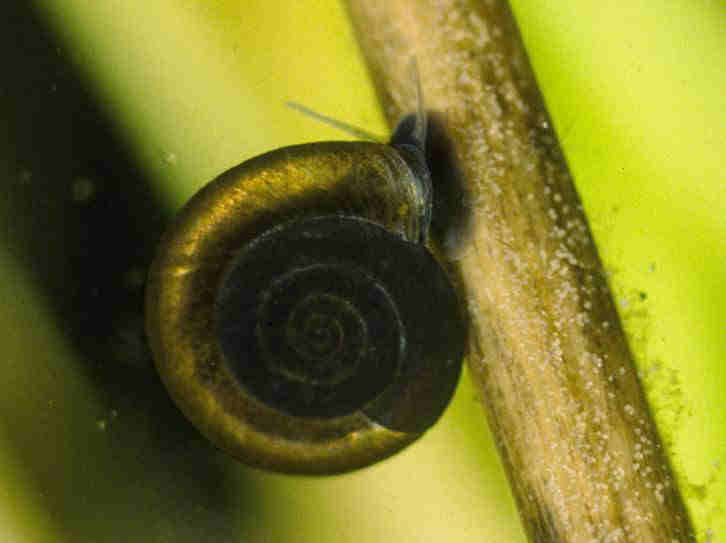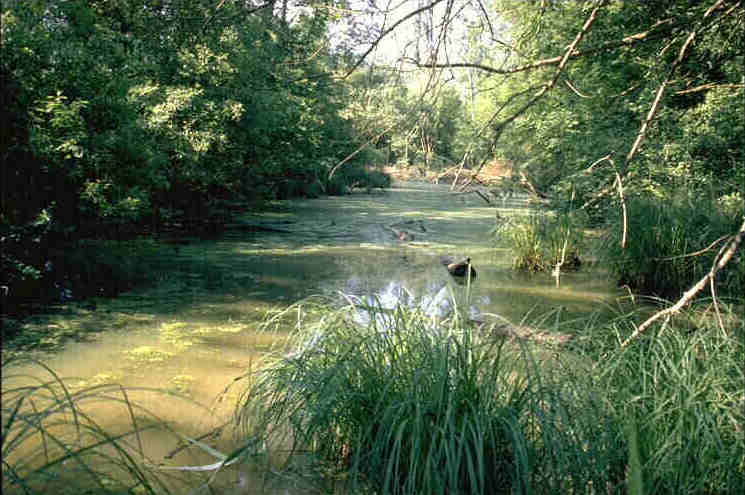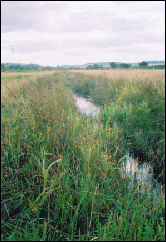

 |
Anisus
vorticulus (Gastropoda, Planorbidae) in its natural and
secondary habitats Fig. 1. Anisus vorticulus. Picture by G. Faulkner from Terrier et al. (2006). |
Since 1st May 2004, the planorbid gastropod Anisus vorticulus
(Troschel, 1834) (Fig. 1) has been listed in the EU Habitats and
Species Directive as a species of community interest, requiring
special areas for conservation (Annex II) and strict protection
(Annex IV). Conservation actions, surveillance, as well as research
programmes have to be undertaken by the member states where the
species occurs. Moreover, since 1991, the species is listed in
the UK Red Data Book (RDB) and the UK ‘Biodiversity Action
Plan’ (BAP), pursuant to conservation and management research
programmes.
A. vorticulus inhabits both water bodies of natural and
of anthropogenic origin (Terrier et al., 2006). Recently,
A. vorticulus was the subject of two studies carried out
separately in water bodies of the French Rhône floodplain,
which can be regarded as a natural habitat for the species (Fig.
2) and in drainage ditches in English humid grasslands (a secondary
man-made habitat) (Fig. 3).
 |
 |
Fig.
2 (near right). A cut-off channel of the French Rhône
floodplain inhabited by Anisus vorticulus. From
Terrier (2006). Fig. 3 (far right). A ditch on Pulborough Brooks, West Sussex, where Anisus vorticulus occurs. From Watson (2002). |
The floodplain study was undertaken as a Master project of the
University of Geneva (Terrier, 2006). The English study was undertaken
as a training project of the University of Carfiff, following
several research projects about Anisus vorticulus, Segmentina
nitida or Valvata macrostoma (Watson, 2002; Watson
and Ormerod 2004a, b, Nieggerbrugge et al., in press).
The aim of this short note is to summarize both studies that are
being prepared for publication and to highlight their findings
relevant to the understanding and conservation of A.vorticulus.
Anisus vorticulus in floodplain
cut-off channels
The study was carried out in the French Upper-Rhone floodplain
where the species was shown to be frequent and locally very abundant
(Castella et al., 2005). It comprised an attempt to model
its occurrence along gradients of environmental variables using
Generalized Additive Models (GAMs) and a comparison of densities
and size structure (using shell diameter) of the populations between
the different sites occupied.
GAMs showed that the occurrence of the species in this floodplain
environment could be predicted by the season and four environmental
variables: the percentage of organic matter of the sediment, the
aquatic vegetation richness and the cover of Elodea canadensis,
Hydrocharis morsus-ranae and Lemna minor. This
model could be used for example to identify candidate locations
for re-introduction. The size-structure of A. vorticulus
populations appeared to be heterogeneous across the floodplain
habitats suggesting that the timing of reproduction and growth
could depend upon local conditions such as temperature or flooding
regime that remain to be identified. The monitoring of the species
in a cut-off channel that underwent severe modifications (dredging
and removal of riparian tree cover) revealed that A. vorticulus
could survive – at least during the short time scale of
the study – strong modifications of its habitat.
Anisus vorticulus in humid grassland ditches
Based upon previous analyses by Watson (2002), which revealed
that gastropod’s conservation value and richness were significantly
greater for ditches occupied by Anisus vorticulus, Segmentina
nitida or Valvata macrostoma, three Red Data Books
(RDB) gastropods, and that these three species could be considered
as “umbrella species”, the research in English humid
grassland ditches was principally set out to answer the following
questions: Do the three RDB species indicate ditches with wider
conservation value? How constant is the composition of mollusc
assemblages associated with the RDB species? Are RDB gastropods
also indicators of ditch conservation value for macrophytes? Finally,
which factors (e.g. dispersal, distance, water quality, and vegetation
structure) best explain the drop out of both RDB species and commoner
ones (non-RDB species) from typical assemblages?
Ordination and classification techniques were used to assess how
species were associated across ditches and to relate gastropod
assemblages to their environment. Analysis of variance was used
to compare the composition and richness of gastropods, bivalves,
molluscs (gastropods and bivalves together) and vegetation (marginal
and aquatic) between ditch clusters, and also their conservation
value. Ditches were classified in three groups characterized by
specific gastropod assemblages. Each gastropod assemblage was
associated by specific vegetation and water chemistry conditions.
More interesting, each RDB species was representative of one of
the three assemblages. Analysis of variance revealed that each
ditch cluster was characterized by a distinct composition and
richness of gastropods, molluscs and vegetation, while representing
the same importance in terms of conservation value. This survey
also confirmed the ‘umbrella’ role of the three RDB
species A.vorticulus, S.nitida and V. macrostoma
that indicated, first, high conservation value in the ditches
where they occur and, secondly, distinct ecological conditions.
Moreover, each RDB species represented wider an assemblage of
associated gastropod molluscs and vegetation.
As an additional question, the project also assessed whether non-RDB
species might indicate locations that hold the RDB species, or
could be suitable following reintroduction. Chi-square test calculated
the statistical significance of the association between each RDB
species and the more common gastropods of their respective cluster.
Segmentina nitida could be indicated by the presence
of Bathyomphalus contortus, Stagnicola (Lymnaea)
palustris and Planorbarius corneus, and Valvata
macrostoma locations by the presence of Hippeutis complanatus
and Bithynia leachii. A. vorticulus could not
be indicated by the presence of any gastropods species.
Concerning A. vorticulus in particular, this study showed
that it can be used as an umbrella species that indicates typical
environmental conditions. It occurred, with its associated species
assemblage, in deeper ditches, with more open water and submergent
vegetation and less alkaline water with less emergent vegetation
cover than the other assemblages.
Perspectives
The juxtaposition of these two sets of studies shows at the same
time the capacity of Anisus vorticulus to adapt to different
types of environments (a semi-natural large river floodplain vs.
man-made ditches), and that the species occurs at sites with particular
environmental conditions in both cases. As shown in previous studies,
the nature and quantity of aquatic vegetation is a key factor
controlling the occurrence of the species in both environments.
Conversely, water chemistry appears to be more determinant in
the English ditches than in the French floodplain. This might
be because the ditches are more directly influenced by agricultural
runoff, than the cut-off channels, generally buffered by riparian
forest.
Continuation of these studies could develop in a more direct comparison
between the two systems where A. vorticulus occurs. In
this respect, it could be important to look for the species in
man-made ditches adjacent to the French floodplain and compare
its requirements there with the results obtained in England. In
both sectors, it would also be important to investigate the connectivity
between populations given the highly fluctuating character of
the floodplain condition, relative to the more stable hydrology
in the ditches.
Acknowledgments
I am sincerely grateful to Prof. Steve Ormerod, Dr. Isabelle Durance
and Dr. Emmanuel Castella for their supervision, patience, and
guidance. I extent my gratitude to the Malacological Society of
London and to the Lucie and Ernst Schmidheiny Foundation (Switzerland)
for their financial support in the research about English grazing
marshlands.
References
| Castella E., Terrier A., Pellaud M. & Paillex A. 2005. Distribution d’Anisus vorticulus (Troschel 1834) | |
| dans la plaine alluviale du Haut-Rhône français. Un Gastéropode Planorbidae listé en annexe de la "directive habitats". Bulletin mensuel de la Société Linnéenne de Lyon, 74, 255-269. | |
| Niggerbrugge, K., Durance, I., Watson, A., Leuven, S.E.W and Ormerod, S.J. In press. Dispersal | |
| and distribution in common wetland gastropods: snail-trail or critical path? Biodiversity Conservation | |
| Terrier A. 2006. Distribution et préférences écologiques d’Anisus vorticulus (Troschel, 1834) (Mollusque, | |
| Gastéropode) dans la zone alluviale du Rhône. Application à la gestion des milieux. Diplôme en Sciences Naturelles de l’Environnement. N° 127. Université de Genève. | |
| Terrier A., Castella E., Falkner F., Killeen I. 2006. Species account for Anisus vorticulus | |
| (Troschel, 1834) (Gastropoda, Planorbidae), a species listed in Annexes II and IV of the habitats directive. Journal of Conchology 39, 193-205. | |
| Watson A.M. 2002. The ecology of four scarce wetland molluscs. Ph.D. Thesis, University of Wales, | |
| Cardiff. | |
| Watson M. and Ormerod S.J. 2004a. The distribution of three uncommon freshwater gastropods in the | |
| drainage ditches of British grazing marshes. Biological Conservation 188, 455-466. | |
|
Watson A.M. and Ormerod S.J. 2004b. The micro-distribution of three uncommon freshwater gastropods |
|
|
in the drainage ditches of British grazing marshes. Aquatic Conservation: Marine and Freshwater Ecosystems 14, 221-236. |
|